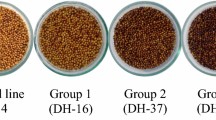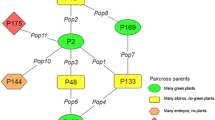Summary
The levels of erucic acid and other fatty acids in seeds of microspore-derived spontaneous diploid plants from crosses between low and high erucic acid parents were examined. The analysis confirmed that erucic acid is simply inherited and is determined by two genes that act in an additive manner. The effects of the genes for erucic acid on the levels of the other fatty acids was also determined and many significant correlations were found. In particular, erucic acid levels were negatively correlated with oleic acid and linoleic acid levels. The study also illustrates several advantages of using haploidy to analyze the inheritance of agronomically important traits. In particular, the number of phenotypic classes is smaller in androgenic populations and differences between classes are greater than in an F2 population.
Similar content being viewed by others
References
Beare JL, Campbell JA, Youngs CG, Craig BM (1963) Effects of saturated fat in rats fed rapeseed oil. Can J Biochem Physiol 41:605–612
Choo TM, Reinbergs E (1979) Doubled haploids for estimating genetic variances in the presence of linkage and gene association. Theor Appl Genet 55:129–132
Choo TM, Reinbergs E, Park SJ (1982) Comparison of frequency distributions of doubled haploid and single seed descent lines in barley. Theor Appl Genet 61:215–218
Choo TM, Reinbergs E, Kasha KJ (1985) Use of haploids in breeding barley. Plant Breed Rev 3:219–252
Chuong PV, Beversdorf WD (1985) High frequency embryogenesis through isolated microspore culture in Brassica napus L. and Brassica carinata Braun. Plant Sci 39:219–226
Craig BM (1961) Varietal and environmental effects on rapeseed. III. Fatty acid composition of 1958 varietal tests. Can J Plant Sci 41:204–210
Dorrel DG, Downey RK (1964) The inheritance of erucic acid content in rapeseed (Brassica campestris). Can J Plant Sci 44:499–504
Downey RK, Craig BM (1964) Genetic control of fatty acid biosynthesis in rapeseed (Brassica napus L.). J Am Oil Chem Soc 41:475–478
Downey RK, Harvey BL (1963) Methods of breeding for oil quality in rape. Can J Plant Sci 43:271–275
Friedt W, Foroughi-Wehr B (1983) Field performance of androgenetic doubled haploid spring barley from F1 hybrids. Z Pflanzenzücht 90:177–184
Gamborg OL, Miller RA, Ojima K (1968) Nutrient requirements of suspension cultures of soybean root cells. Exp Cell Res 50:151–158
Harvey BL, Downey RK (1964) The inheritance of erucic acid content in rapeseed (Brassica napus L.). Can J Plant Sci 44:104–111
Jonsson R (1973) Breeding for low erucic acid content in summer turnip rape (Brassica campestris L. var annua L.). Z Pflanzenzücht 69:1–18
Jonsson R (1974) Breeding for low erucic acid content in winter turnip rape (Brassica campestris L. var biennis L.). Z Pflanzenzücht 73:259–268
Jonsson R (1977a) Erucic acid heredity in rapeseed (Brassica napus L. and Brassica campestris L.). Hereditas 86:159–170
Jonsson R (1977b) Breeding for improved oil and meal quality in rape and turnip rape. Hereditas 87:205–218
Jonsson R (1978) Erucic acid heredity in rapeseed. Proc 5th Int Rapeseed Conf, Organizing Committee of 5th International Rapeseed Conference, Malmo
Jonsson R, Persson C (1983) Breeding for improved fatty acid composition in rapeseed. Proc 6th Int Rapeseed Conf, Organizing Committee of 6th International Rapeseed Conference, Paris
Kasha KJ, Reinbergs E (1975) Utilization of haploids in barley. In: Gaul H (ed) Barley genetics III, Thiemig, München, pp 307–315
Keller WA, Armstrong KC (1978) High frequency production of microspore-derived plants from Brassica napus anther culture. Z Pflanzenzücht 80:100–108
Kondra ZP, Thomas PM (1975) Inheritance of oleic, linoleic and linolenic acids in seed oil of rapeseed (Brassica napus). Can J Plant Sci 55:205–210
Krzymanski J, Downey RK (1969) Inheritance of fatty acid composition in winter forms of rapeseed, Brassica napus. Can J Plant Sci 49:313–319
Lichter R (1982) Induction of haploid plants from isolated pollen of Brassica napus. Z Pflanzenphysiol105:427–434
Morrison RA, Evans DA (1988) Haploid plants from tissue culture: new plant varieties in a shortened time frame. Biotech 6:684–690
Nitsch C, Nitsch JP (1967) The induction of flowering in vitro in stem segments of Plumbago indica L. I. The production of vegetative buds. Planta 72:355–370
Park SJ, Walsh EJ, Reinbergs E, Song LSP, Kasha KJ (1976) Field performance of doubled haploid barley lines in comparison with lines developed by the pedigree and single seed descent methods. Can J Plant Sci 56:467–474
Reinbergs E, Song LSP, Choo TM, Kasha KJ (1978) Yield stability of doubled haploid lines of barley. Can J Plant Sci 58:929–933
Röbbelen G, Thies W (1973) Inheritance of polyenoic fattyacids and their selection in oil seeds. Genetics 74:S231
Shehata AY, DeMan JM, Alexander JC (1970) A simple and rapid method for the preparation of methyl esters of fats in milligram amounts for gas chromatography. Can Inst Food Technol J 3:85–89
Song LSP, Park SJ, Reinbergs E, Choo TM, Kasha KJ (1978) Doubled haploid vs the bulk plot method for production of homozygous lines in barley. Z Pflanzenzücht 81:271–280
Stefansson BR (1983) The development of improved rapeseed cultivars. In: Kramer JKG, Sauer FD, Pigden WJ (eds) High and low erucic acid rapeseed oils: production usage chemistry and toxilogical evaluation. Academic Press, Don Mills, pp 143–159
Stefansson BR, Hougen FW (1964) Selection of rape plants (Brassica napus) with seed oil practically free from erucic acid. Can J Plant Sci 44:359–364
Stefansson BR, Storgaard AK (1969) Correlations involving oil and fatty acids in rapeseed. Can J Plant Sci 49:573–580
Stefansson BR, Hougen FW, Downey RK (1961) Note on the isolation of rape plants with seed oil free from erucic acid. Can J Plant Sci 41:218–219
Thies W (1968) Die Biogenese von Linol- und Linolensäure in den Samen höherer Pflanzen, insbesondere Raps und Rubsen, als Problem der Ölpflanzenzüchtung. Angew Bot 42:140–154
Thomas E, Wenzel G (1975) Embryogenesis from microspores of Brassica napus. Z Pflanzenzücht 74:77–81
Author information
Authors and Affiliations
Additional information
Communicated by G. Wenzel
Rights and permissions
About this article
Cite this article
Siebel, J., Pauls, K.P. Inheritance patterns of erucic acid content in populations of Brassica napus microspore-derived spontaneous diploids. Theoret. Appl. Genetics 77, 489–494 (1989). https://doi.org/10.1007/BF00274268
Received:
Accepted:
Issue Date:
DOI: https://doi.org/10.1007/BF00274268




